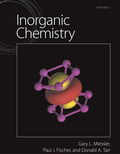
For each of the following reactions identify the acid and the base. Also indicate which acid—base definition (Lewis, Brønsted-Lowry) applies. In some cases, more than one definition may apply.
a.
b.
c.
d.
e.
f.
(a)
Interpretation: The acid and base need to be identified in the following reaction. Also, the applied acid-base definition needs to be indicated.
Concept Introduction: According to Lewis concept, an acid is an electron pair acceptor. It acts as an electrophile and has vacant orbitals. On the other hand, a base is an electron-pair donor. It acts as a nucleophile and has lone pair of electrons.
According to Bronsted-Lowry acid-base theory, an acid can donate a proton
Answer to Problem 6.1P
Explanation of Solution
The given acid-base reaction is as follows:
In the above reaction, Al in
Here,
(b)
Interpretation: The acid and base need to be identified in the following reaction. Also, the applied acid-base definition needs to be indicated.
Concept Introduction: According to Lewis concept, an acid is an electron pair acceptor. It acts as an electrophile and has vacant orbitals. On the other hand, a base is an electron-pair donor. It acts as a nucleophile and has lone pair of electrons.
According to Bronsted-Lowry acid-base theory, an acid can donate a proton
Answer to Problem 6.1P
Explanation of Solution
The given acid-base reaction is as follows:
Here,
In the above reaction,
Therefore,
(c)
Interpretation: The acid and base need to be identified in the following reaction. Also, the applied acid-base definition needs to be indicated.
Concept Introduction: According to Lewis concept, an acid is an electron pair acceptor. It acts as an electrophile and has vacant orbitals. On the other hand, a base is an electron-pair donor. It acts as a nucleophile and has lone pair of electrons.
According to Bronsted-Lowry acid-base theory, an acid can donate a proton
Answer to Problem 6.1P
Explanation of Solution
The given acid-base reaction is as follows:
In the above reaction, Ni has vacant orbitals, thus it can accept electron pairs (act as ab electrophile). Due to the lone pair of electrons on the N atom in
Here,
This can be represented as follows:
(d)
Interpretation: The acid and base need to be identified in the following reaction. Also, the applied acid-base definition needs to be indicated.
Concept Introduction:
According to Lewis concept, an acid is an electron pair acceptor. It acts as an electrophile and has vacant orbitals. On the other hand, a base is an electron-pair donor. It acts as a nucleophile and has lone pair of electrons.
According to Bronsted-Lowry acid-base theory, an acid can donate a proton
Answer to Problem 6.1P
Explanation of Solution
The given acid-base reaction is as follows:
In the above reaction, due to the lone pair of electrons on the N atom in
Here,
This can be represented as follows:
(e)
Interpretation: The acid and base need to be identified in the following reaction. Also, the applied acid-base definition needs to be indicated.
Concept Introduction: According to Lewis concept, an acid is an electron pair acceptor. It acts as an electrophile and has vacant orbitals. On the other hand, a base is an electron-pair donor. It acts as a nucleophile and has lone pair of electrons.
According to Bronsted-Lowry acid-base theory, an acid can donate a proton
Answer to Problem 6.1P
Explanation of Solution
The given acid-base reaction is as follows:
The above reaction is a redox reaction. Here, the oxidation state of S in
The oxidation state of S changes from +4 to +6 as S donates an electron pair. Similarly, the oxidation state of Cl changes from +5 to +4 because it accepts an electron pair (there are 2
Therefore,
This can be represented as follows:
(f)
Interpretation: The acid and base needto be identified in the following reaction. Also, the applied acid-base definition needs to be indicated.
Concept Introduction: According to Lewis concept, an acid is an electron pair acceptor. It acts as an electrophile and has vacant orbitals. On the other hand, a base is an electron-pair donor. It acts as a nucleophile and has lone pair of electrons.
According to Bronsted-Lowry acid-base theory, an acid can donate a proton
Answer to Problem 6.1P
Explanation of Solution
The given acid-base reaction is as follows:
In the above reaction,
Here,
Therefore, HF act as both Bronsted-Lowry and Lewis acid and
Want to see more full solutions like this?
Chapter 6 Solutions
EBK INORGANIC CHEMISTRY
Additional Science Textbook Solutions
Physics for Scientists and Engineers: A Strategic Approach, Vol. 1 (Chs 1-21) (4th Edition)
Chemistry: An Introduction to General, Organic, and Biological Chemistry (13th Edition)
Cosmic Perspective Fundamentals
Laboratory Experiments in Microbiology (12th Edition) (What's New in Microbiology)
Human Anatomy & Physiology (2nd Edition)
Microbiology: An Introduction
- Briefly explain chemical potential.arrow_forwardReason whether it is possible to determine changes in the Galvani potential difference at the metal-solution interface.arrow_forwardObtain the standard potential at 25°C of the Cu* I Cu | Pt electrode from the standard potentials E° Cu²+/Cu = 0.341 V and E Cu²+ /Cu+ = 0.153 V.arrow_forward
 Chemistry: Principles and ReactionsChemistryISBN:9781305079373Author:William L. Masterton, Cecile N. HurleyPublisher:Cengage Learning
Chemistry: Principles and ReactionsChemistryISBN:9781305079373Author:William L. Masterton, Cecile N. HurleyPublisher:Cengage Learning
